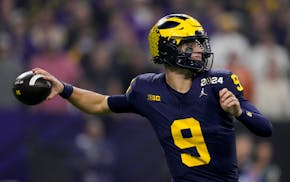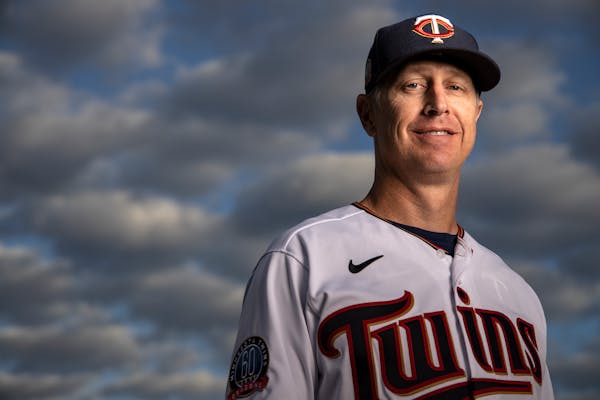FORT MYERS, FLA. – Thursday night, Byron Buxton spun in center field at JetBlue Park, sprinted back, leapt, made a routinely spectacular catch, and bounced off the wall.
Every such play by Buxton is a suspense movie in miniature, prompting a sudden intake of breath, a pause, and then a cheer or gasp, depending on whether Buxton remains upright and intact.
Which raises a question pertinent to the Twins' potential and Buxton's future:
If Major League Baseball can deaden the ball, why can't it deaden the walls?
Whether because of machismo, stupidity, traditionalism or inertia, men's professional sports have always lagged when it comes to safety.
Big-league hitters weren't required to wear a helmet at bat until 1971. Masks didn't become uniform for NHL goalies until a few years later.
In 2021, Major League Baseball features extended netting to protect fans, a crackdown on beanbrawls, rules that prevent violent takeout slides, and a new experiment in the minors featuring larger bases to better protect fielders. Safety has become a priority whether you're sitting down the third-base line or playing first base.
So why don't big-league teams add padding to their outfield walls? Get a marshmallow company to sponsor it.
"He wants to catch everything, and that's a part of him," Twins manager Rocco Baldelli said. "It's hard to extract that and tell him, no, we're going to separate this from you. We're here to make small adjustments that could possibly have a big effect."
The Twins have Buxton playing deeper, meaning he won't have to run as far or fast to get to the wall, and will meet the wall on off-center flies at more oblique angles. They have spoken with him about taking fewer chances, while acknowledging that what has made Buxton possibly the game's best outfielder is his belief that he can catch everything subject to the laws of gravity.
Buxton has managed to be healthy for just six plate appearances in the Twins' past two playoff series. That he could be the key to the Twins winning their first postseason series since 2002 is merely a theory, but it's a pretty good one.
Looking at Buxton's statistics without context is to be unimpressed. He's been in and out of the big leagues since 2015 and his career batting average is .238.
He has also spent an inordinate amount of time recovering from injuries, so in his case extrapolating his best months might provide more insight into what he's capable of.
He has had bad months. He looked unprepared for the big leagues in his first season, and he's had slumps during which he looked unable to decipher big-league pitching.
But here's a rundown of the months where he has looked like a superstar:
• September/October 2016, he hit .287 with a .653 slugging percentage, a 1.011 OPS and hit nine home runs in 101 at-bats.
• In August 2017, he hit .324 with an OPS of .973 and eight homers in 105 at-bats.
• In June 2019, he hit .289 with a .969 OPS.
• In September/October 2020, he hit .296 with a 1.022 OPS and eight homers in 62 at-bats.
Combine that star-quality production with superlative fielding and speed, and you have the rare, modern, five-tool franchise player.
But he has to play to produce. He will become a free agent after the 2022 season, and his value in short bursts will be overwhelmed by his unavailability if he continues to get hurt.
"I think he's had an unusual amount of bad luck," Twins General Manager Thad Levine said. "We have talked to him quite a bit about the walls and allowing them to treat him with greater care than they have so far in his career.
"When the ball is in the air, he believes it is his job to catch it at all costs. I think over the years, we've tried to impress upon him that we would much prefer to see an occasional double if that means him staying on the field and remaining healthy."
Talking to him might work. A center field wall padded with bubble wrap might work better.
Jim Souhan's podcast can be heard at TalkNorth.com. On Twitter: @SouhanStrib. jsouhan@startribune.com

Souhan: Wolves fans made Game 1 special. Now bring on Game 2.

Souhan: Should Vikings even consider McCarthy in NFL draft?

Souhan: NAW erases Suns' lead, Game 1 advantage with big performance

Souhan: This is KAT's chance to prove Flip Saunders was right


